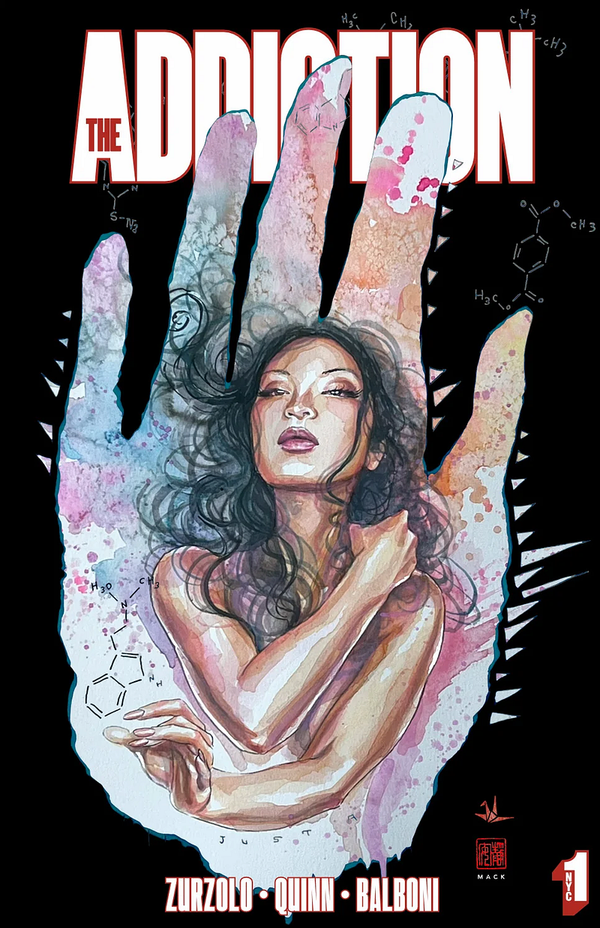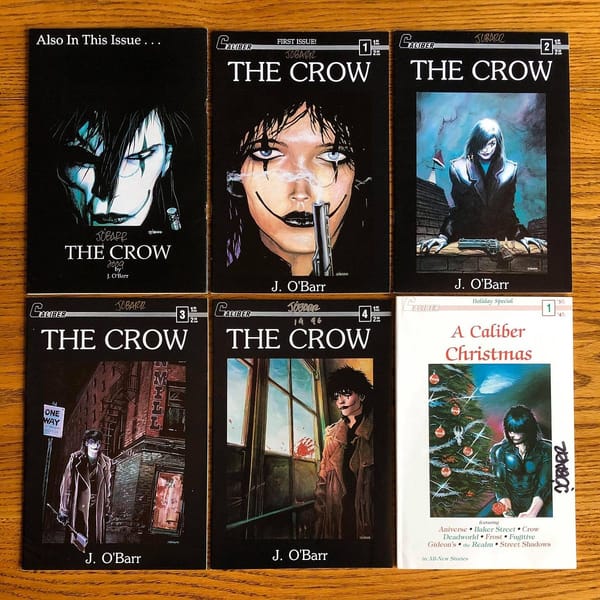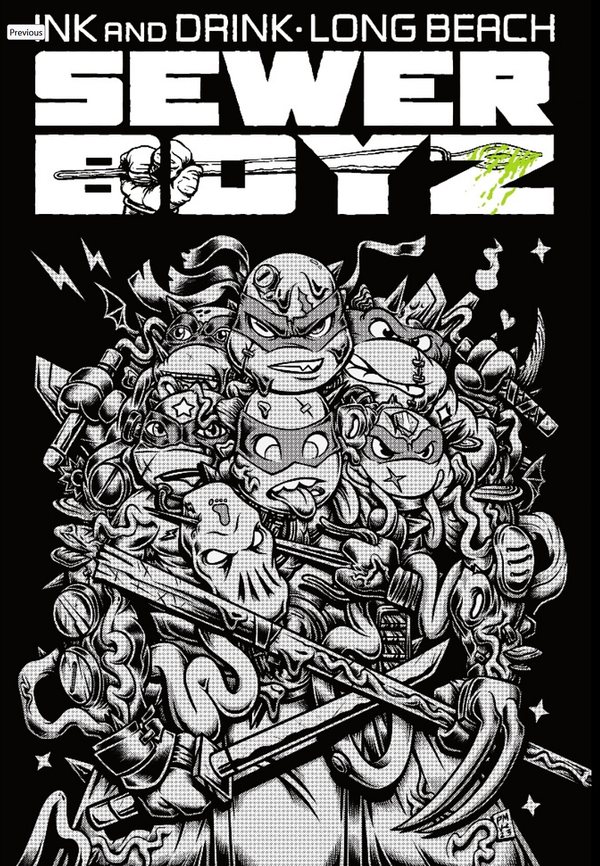Razor’s Chronology (Is Ridiculously Complicated)
This article was written by Michael Crisman and originally published in 2019 at steemit as part of his Michael’s Longbox series. It’s…
This article was written by Michael Crisman and originally published in 2019 at steemit as part of his Michael’s Longbox series. It’s republished here with permission from Mike and updated/clarified information on Mystery Graphix. For more on Mystery Graphix, see the following Instagram posts: 1, 2, 3, 4— KF.
So for the past few months I’ve been slowly chipping away at a project I thought would be relatively straightforward. With the announcement that Emma Dumont has been cast as the titular protagonist of the film, I figured now’s as good a time as any to put my Razor comic collection in chronological reading order, instead of just broken down by series numbers and titles. I assumed this would be a relatively painless task, despite Razor’s appearance in several dozen titles. The last time I was this wrong about something, my wife would be happy to tell you all about it. Look up ‘Mongolian Clusterfuck’ on UrbanDictionary, and the top entry should read, “See: RAZOR CHRONOLOGY”. What the hell have I done to myself?
Note: most cover scans for this article come from the Comic Book Database.
Determining exactly when a given story takes place within comic continuity is usually impossible, unless the writer/editor explicitly states the when and the where. And honestly, the precise timing of the events isn’t important. For stories where it is, the writers will choose some landmark events to help the reader figure out where it falls in the grand scheme of things. For instance, if you read a Batman tale where Tim Drake’s Robin is present, or someone references the Joker having killed Jason Todd, you know it has to take place in a post-A Death in the Family continuity. Generally, that’s all you need to know. Events in The Incredible Hulk #181 are going to follow the events in The Incredible Hulk #180, and will precede The Incredible Hulk #182. Even in the event of major arcs that span multiple titles like The Death of Superman, or world-changing crossovers like Identity Crisis, you can usually look at the publication dates and figure out what came when. Trade paperback collections will usually reprint as much of the material as necessary or possible from all the books out there; the Superman: Our Worlds At War omnibus, for instance, features not just Superman titles but Batman, Young Justice, Green Lantern, and the main Our Worlds At War issues (among others), collated and collected in their proper reading order. How handy!
You can’t rely on anything like this for Razor. London Night Studios wove their properties in and out of the continuity with reckless abandon, starting arcs in one title, continuing them on in a second, having them meet up in a one-shot or annual, then split apart to do their own things until fate intervenes and brings them together again. Even if you line everything up numerically by title, this won’t help you. I’ll try and explain.



Razor didn’t begin with Issue #1. The vigilante’s origins trace to an issue 0 printed in December 1991. The series was originally promoted in Midnight Screams #2, an anthology comic from Mystery Graphix Press, by Mystery Graphix Press publisher Jack Slattery. The same issue features a story written by Kevin Hill, who would go on to write Rose and Gunn, and illustrated by Razor creator Everette Hartsoe. Another Midnight Graphix book, Scream Queen # 1, advertised a Razor issue “0” as well as a planned appearance by Razor in Midnight Screams # 3, along with Hartsoe’s “Codename: Heavy Metal.” I don’t think Midnight Screams # 3 ever saw print, but there are a few versions of Razor # 0.
The first was known as “Razor 0-black”, this was a limited 300-copy exploratory print run commissioned by creator Everette Hartsoe to gauge the plausibility of an on-going series:
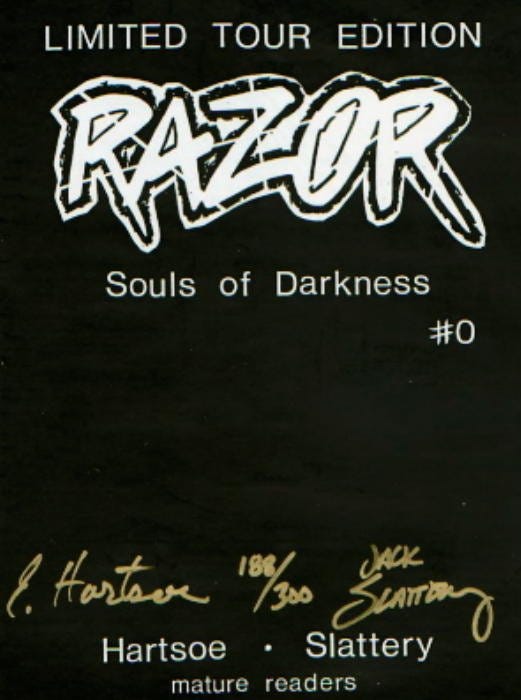
Following this is a different Razor Zero book, printed in March of 1992 by Mystery Graphix and Hartsoe’s London Night Studios. This is a reprint of 0-black, but with actual cover art instead of a black piece of paper with a title graphic and two signatures. There’s also a version with a different cover from Tim Tyler’s Fathom Press. We don’t see Razor #1 until August of 1992, also from Fathom Press. London Night does eventually put out their own printing of #1…in 1994. Oh, and London Night published yet another version of Razor # 0 in 1995, which features the same story but with redrawn artwork.

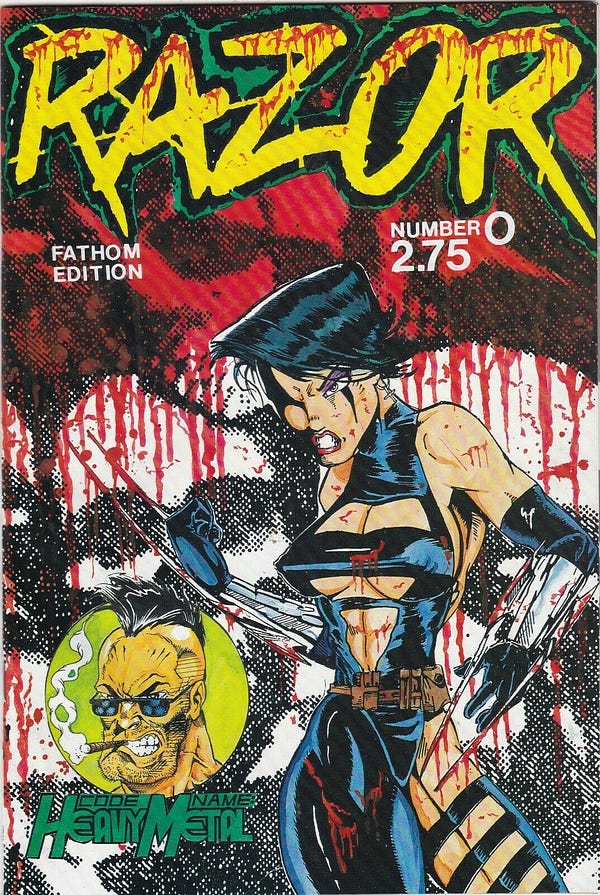



Part of what makes Razor continuity such a nightmare is the number of reprints and variants, all published at different times by different studios. In addition, the book’s covers were notorious for omitting important details like publication dates, numbers, and even titles, so you get stuff like this:

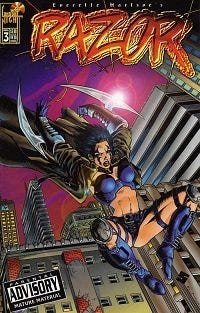

That’s Razor Vol. 1, #3, Razor: Vol. 2, #3, and Razor: Burn #3 from left to right. For reasons known only to intelligence beyond our dimension, the Razor: Burn mini-series dropped the “Burn” identifier from the covers of issues 3, 4, and 5. If you aren’t careful and don’t know any better, you can confuse copies of these as possibly variant covers of the normal numbered series (or Volume 2, which we’ll talk about later) and either skip over them when you need them for your collection, or pick them up thinking you’re filling gaps when you really aren’t. Unless you can open the books and check the indicia for yourself, or you know what you’re looking for because you’ve done your research, this is a colossal pain in the butt.
The continuity nightmare is only just beginning though. You can pick up Razor #0 in one of its many incarnations for the first Razor story, but if you want Razor’s origin story, you had to wait until 1996 for the release of the Cry No More one-shot:

This is Hartsoe pulling a “George Lucas maneuver” move three years before such a phrase made sense.
OK, so you’ve got your copy of Cry No More, you’ve got Razor #0, and you’ve built up a collection of Razor’s stories running from #1 to #12 without any mix-ups of different volumes or mini-series which left their subtitles off the front cover. Now you’re ready to start reading, right? Of course you are…
…In a parallel gawddamn dimension. You need Razor and Shi Special #1, which takes place between Cry No More and #0, before that party can begin. Oh sure, you could pick up Razor Annual #1instead, but that’s only got 3/4ths of the Razor/Shi crossover contained within Razor and Shi Special #1, and you want the full story, right? Got it? Good. Now the real fun starts, because this is where London Night starts twisting numbers into things they were never meant to be.
Razor #1 through Razor #5 all run in consecutive order. That is, the events of #2 follow the events of #1, #3 follows #2, and so forth. Five solid issues of uninterrupted story arc dubbed “The Angel in Black.” Prior to the events in this story arc, Razor spends her nights cleaning up the streets Batman-style, giving the pimps, gun runners, gang bangers, drug pushers, and crime lords reasons to reconsider their chosen professions. That stops when she decides to go after her main target, Roman Von Drake. Von Drake runs the largest criminal organization in Queen City, and it was Von Drake who murdered Razor’s father and kidnapped her sister. She’s also got problems with law enforcement officers trying to stop her from dishing out her brand of brutal justice. A detective named Alex London has put two and two together and figured out Razor is none other than Nicole Mitchell, daughter of Frank Mitchell, who was an officer himself. Seeing that Razor has been systematically targeting the gangs and dealers associated with Von Drake’s underworld, London figures Razor is on a collision course with Von Drake and goes to stop her before she gets herself killed.
So far so good. You know that can’t last.
We come to Razor #6 and Razor #7 which are one-shots with no bearing on the “Angel in Black” story arc, and actually take place prior to the events of Razor #0, so put them back there with Cry No More, and Razor and Shi Special #1 in the chronology.
Things get back to normal with Razor #8 and Razor #9, which conclude the “Angel in Black” arc, and #10 which follows on “Angel in Black”’s heels. Nicole leaves Queen City, having completed her rampage of vengeance, and heads to New York to start a new life. Of course, the memories of the past won’t leave her alone, which is where #11 and #12 come in with a two-part arc entitled “Rituals.” Razor #12 concludes Volume 1 of the numbered series, but the story continues in the five-issue Razor: Burn mini-series…

…while the monthly Razor book keeps going as Razor: Uncut starting with issue #13. Incidentally, this means there are no issues #1–12 of Razor: Uncut so don’t bother looking — this drove me nuts like a steering wheel affixed to my crotch for years until I figured it out. Despite what one might infer from the title, Uncut isn’t a “director’s cut” or otherwise unedited version of previously told tales. Uncut starts prior to the “Angel in Black” arc, but sometimes references events that happen later in the actual story chronology, or it just throws off its hat and skips around like a meth head in a square dancing competition.
It’s fair to say Uncut isn’t just prequel stories, but also sequels to the “Angel in Black” main storyline, and basically an alternate universe all its own. Razor: Uncut inhabits what I’ll call the “Black and White” continuity line, because it’s produced in black and white. A three-issue side-series entitled Razor: The Suffering (issues of which were subject to innumerable delays due to Hartsoe juggling too many projects) also inhabits this continuity line, as do a few other crossovers produced around this same time period.
Back to Burn which, being only five issues, you’d think could keep a semblance of normality going, aaaaaand you’re wrong again. Smack-dab in between Burn #3 and Burn #4 you get the events depicted in Razor: Uncut #21, then between Burn #4 and Burn #5 you get Razor #1/2, a book one could only acquire via direct mail from Overstreet’s Fan magazine. On the bright side, every Razor #1/2 is signed by Hartsoe. On the down-side, not only is it pricey to add to your collection, but it’s also not labeled sensibly — calling it “Razor: Burn 4.5” or something was apparently too hard, so you wind up with a book that, on the cover, looks like it should slot between Razor #0 and Razor #1. But that would be logical. Fortunately, you’re not missing out on anything major story-wise if you skip this one
London Night handles logic like your average street preacher.
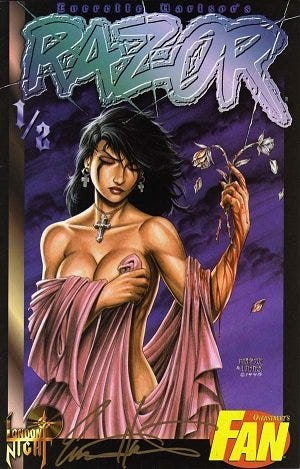
Burn is significant for being the first Razor series in full color, which was big for an indie book of the day since most small press studios only published in black and white to keep costs down. Razor, however, was regularly pushing 10,000 sales per issue at this point. What’s more surprising is that London Night kept the cover price at $3.00, despite the color issues being printed on higher-quality paper stock. Good on them for not sticking it to the consumers for that. After the oddity that is Burn + Uncut #21 + Razor #1/2 + last issue of Burn, we move into the Torture mini-series.
Because this is a London Night title, it’s a seven-issue series that runs from #0 to #6. Thankfully for readers, they all came out in the proper order this time, so #0 is dated December of 1995, #1 is January of 1996, and so forth. Holy cow, it’s a London Night Christmas miracle! :D
Unfortunately, this is the easiest time we’ll have dealing with Razor’s continuity. At the conclusion of Torture #6, the series splits off into multiple directions. Razor’s story continues in the Razor/Morbid Angel: Soul Search three-issue series…

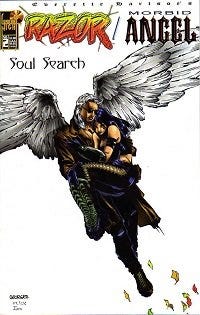

…while Stryke’s story spins off into the twelve-issue Ultimate Strike series. A third comic, Hellborne #1, is mentioned as coming soon, but as far as I can tell it never appeared on shelves. It’s possible the story meant for this book wound up split between the first couple of issues of Full Metal Fiction, but I’m not positive.
After the Morbid Angel crossover, Razor goes back to a regular monthly series for seven issues for Volume 2. Strangely, the first five are in full color, but the final two are black and white. Why? Well, it’s only speculation on my part, but by this point we were well into the plunging comic book market of the mid-90’s. Between Marvel’s bankruptcy filing and the bottom falling out of the speculator market (something London Night rode damn good and hard during their heyday), the entire industry took a beating, and independent studios took that beating the way Abraham from The Walking Dead did: like a champ. (Too soon…?)
The series closes with this cover:

Wait, “Final Issue”? Well, of course, you can’t keep Razor down for long. But I think, for now, that’s all we need to get into. Everything else is crossovers, guest appearances in other characters’ books, and a run with Avatar Press (about which the less said the better) where the ‘when’ and the ‘why’ don’t much matter. London Night was a madhouse of wild ideas and products, and Hartsoe a marketing genius who saw a niche and filled it like an asphalt paving company sealing potholes in Indianapolis. I have to respect that.
To Recap!
Here’s the Cliff’s Notes on the chronological reading order for Razor books as best I can determine for the first few years of her existence:
Razor: Cry No More
Razor: Razor and Shi Special #1
Razor: 6, 7
Razor: Uncut 13, 14, 15, 16, 17, 18, 19
Razor: 0-Black, 0, 1, 2, 3, 4, 5, 8, 9, Annual #2, 10, 11, 12
Razor: Burn 1, 2, 3
Razor: Uncut 21
Razor: Burn 4
Razor: 1/2
Razor: Burn 5
Razor: Torture 0, 1, 2, 3, 4, 5, 6
Razor/Morbid Angel: Soul Search 1, 2, 3
Razor v.2: 1, 2, 3, 4, 5, 6, 7
Now I’ve no idea which, if any, of these books will be used to pen the final iteration of the script that becomes Razor in 2019. But if you want to get in on the ground floor, this here’s your guide to dealing with the complexities of London Night Studios’ premiere bad girl in her early days. Some of these story arcs, like Burn and “Angel in Black” have been compiled into Trade Paperbacks, or reprinted in the Razor: Archives line, which means you don’t need to drop a fortune to read those early storylines, but this is up to individual preference. This is a hard series to collect these days. Don’t let my months of work trickle away to nothing. I guaran-damn-tee if the movie takes off, these books will likely skyrocket with it, so the time to move is now.
